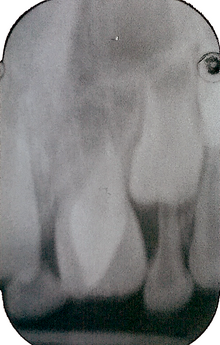| Talon cusp | |
|---|---|
| Other names | Eagle's talon, dens evaginatus, interstitial cusp, tuberculated premolar, evaginated odontoma, supernumerary cusp[1] |
 | |
| Periapical radiograph of talon cusp on a partially erupted upper left permanent maxillary incisor in an 8 year-old male of Arabic descent | |
| Specialty | Dentistry |
Talon cusp is a rare dental anomaly[2] resulting in an extra cusp or cusp-like projection on an anterior tooth, located on the inside surface of the affected tooth. Sometimes it can also be found on the facial surface of the anterior tooth.[3]
The term 'talon cusp' refers to the same condition as dens evaginatus; however, talon cusp is more specifically the manifestation of dens evaginatus on the anterior teeth. Talon cusp can be simply defined as hyperplasia of the cingulum of an anterior tooth.
Although talon cusp may not appear serious, and in some people may be completely benign, it can cause clinical, diagnostic and functional problems, and alters the appearance of a person's teeth. The condition was first described by W.H. Mitchell in 1982 and named by J. Kimball Mellor B.S., D.D.S. and Louis W. Ripa, D.D.S., M.S.[4] due to its similar appearance to an eagle's talon. Some sources define a talon cusp as an extra cusp which extends at least half the distance between the cementoenamel junction and the incisal edge of the tooth.[5] Other sources classify all enlarged cingula as talon cusps, and classify them according to the degree of enlargement.[5]
The incidence of talon cusp has been found to range from 1% to 6% of the population.[vague][6] Talon cusp tends to occur on permanent teeth only,[5] being very rare in deciduous teeth.[5] In most cases, the involved teeth are the permanent maxillary lateral incisors (55%), followed by maxillary central incisors (33%), mandibular incisors (6%), and maxillary canines (4%).[5]
- ^ Praveen, P (February 2011). "Talon Cusp in a Primary Tooth" (PDF). Journal of Dental Sciences and Research. 2 (1): 35–40. Retrieved November 1, 2015.
- ^ Ozcelik, Bahar; Atila, Burcu (2011-01-01). "Bilateral Palatal Talon Cusps on Permanent Maxillary Lateral Incisors: A Case Report". European Journal of Dentistry. 5 (1): 113–116. doi:10.1055/s-0039-1698866. ISSN 1305-7456. PMC 3019756. PMID 21228961.
- ^ Shirolkar S, Das M, Gayen K, Mukhopadhayay S, Sarkar S, Roychowdhury S. Managing a facial talon: A rare morphological variation on maxillary permanent central incisor. J Dent Res Rev [serial online] 2021 [cited 2021 Sep 5];8:217-20. Available from: https://www.jdrr.org/text.asp?2021/8/3/217/324411
- ^ Mellor, J. Kimball; Ripa, Louis W. (1970-02-01). "Talon cusp: A clinically significant anomaly". Oral Surgery, Oral Medicine, Oral Pathology. 29 (2): 225–228. doi:10.1016/0030-4220(70)90089-7. PMID 5262843.
- ^ a b c d e Neville BW; Chi AC; Damm DD; Allen CA (13 May 2015). Oral and Maxillofacial Pathology. Vol. 1. Elsevier Health Sciences. pp. 80–81. doi:10.1007/s12105-007-0007-4. ISBN 978-1-4557-7052-6. PMC 2807501. PMID 20614286.
{{cite book}}:|journal=ignored (help) - ^ Neville, B.W., D. Damm, C. Allen, J. Bouquot. Oral & Maxillofacial Pathology. Second edition. 2002. Page 78. ISBN 0-7216-9003-3.